|
|
File
“Giuseppe Zannato” Naturalistic and Archaeological Museum – Montecchio Maggiore
|
Piazza Marconi 15 – 36075 Montecchio Maggiore (VI)
– Fax 0444 492565 |
  |
|
Summary
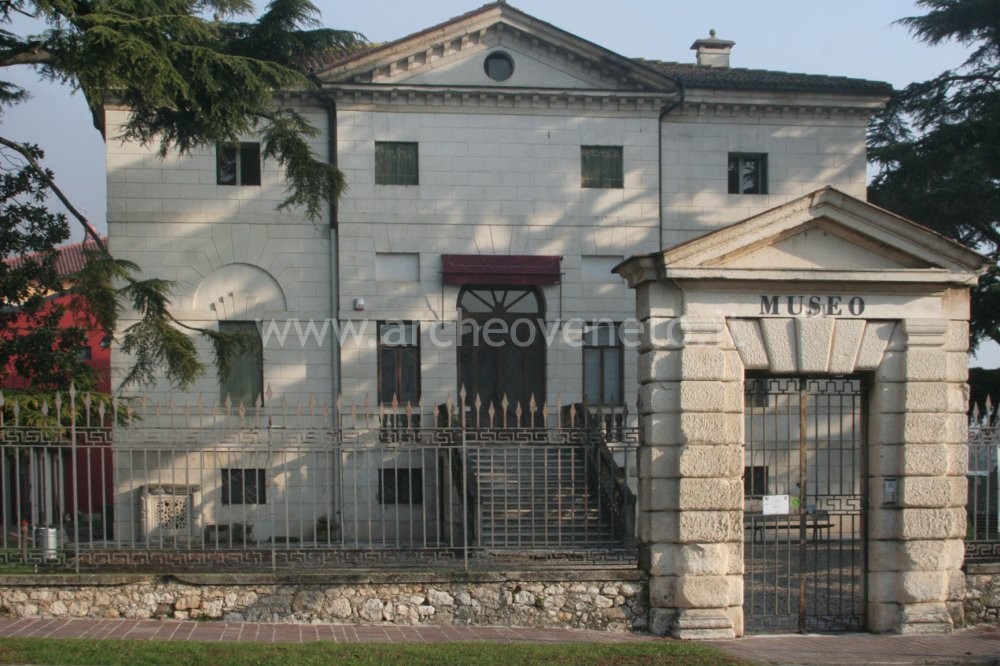
The “Giuseppe Zannato” Naturalistic and Archaeological Museum, presently located inside the Nineteenth century Villa Lorenzoni was called after its first curator and opened in 1922 with a lively didactic aim. The exhibition is mainly composed of two recently rearranged sections, an archaeological section (with five rooms distributed in chronological order) and a naturalistic one. The Museum is part and is also the head office of the Network of Local Museums of Agno-Chiampo which includes nine municipalities of the Western area of Vicenza.
Collection history
The Museum was opened in 1922 at the primary school “A. Manzoni” by Giuseppe Zannato who donated his heterogeneous collection of archaeological and naturalistic material (palaeontological and mineralogical items). In the 1960’s, after the collection lost some of its pieces during the Second World War, the museum was moved to its present location (piazza Marconi) where the exhibition took on, over the years and thanks to several donations, quite a regional character. In 2001, the experience of the Network of local museums started reaching its peak in 2007, when the exhibition took on a new appearance.
|

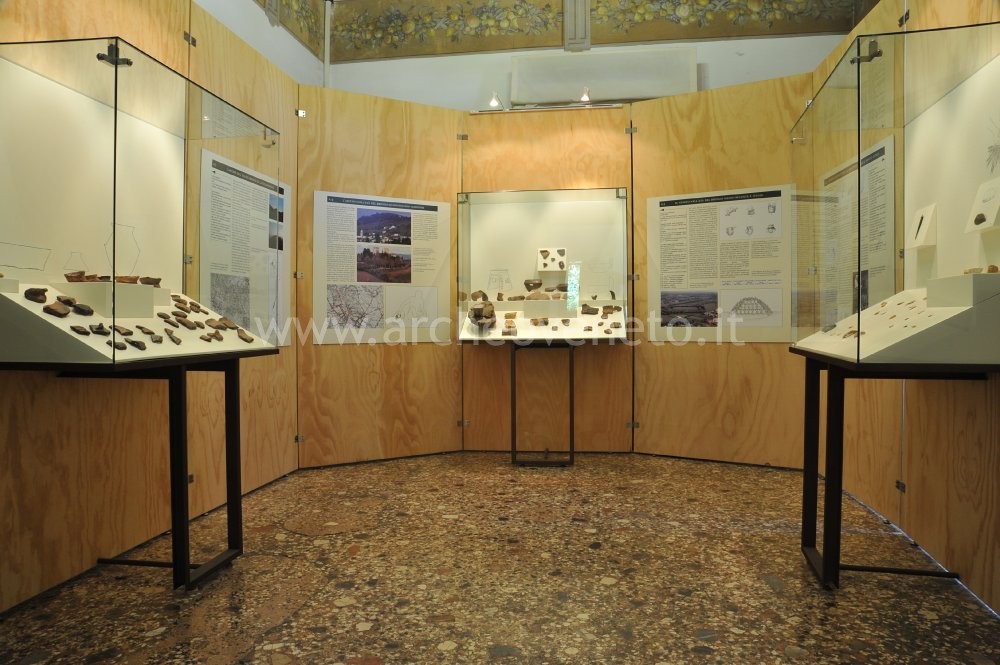 The first exhibition room is dedicated to the prehistoric settlements located in the area of Vicenza. The museum starts with a panel which gives an overview of the settlements studied in the whole province of Vicenza from the Middle Paleolithic Era to the Bronze Age. The subject focuses on the description of the various lithic material collected during the field work in the region of Montecchio. The same display case contains also a copper dagger blade dating back to the Ancient Bronze Age collected during the 1914 excavations in a burial in Via Conti Gualdo. During the Middle and Recent Bronze Age, the Venetian area underwent a real colonization, which included both the mountains and the coasts. Even the hills of Montecchio were massively inhabited during that period; an example of that is the abundant ceramic material found in several places of the interested region (Monte Nero, Castelli Fondo Colombara). In the last part of the room, there are finds related to the hill settlements of the Bronze Age of Castelgomberto (recent and final Bronze Age and beginning of the Iron Age). The archaeological finds accidentally discovered in the second half of the twentieth century are mostly pottery. Various fragments of biconical and truncated conical decorated pots, cups and bowls, different-necked cups and spindle whorls are displayed here. The first exhibition room is dedicated to the prehistoric settlements located in the area of Vicenza. The museum starts with a panel which gives an overview of the settlements studied in the whole province of Vicenza from the Middle Paleolithic Era to the Bronze Age. The subject focuses on the description of the various lithic material collected during the field work in the region of Montecchio. The same display case contains also a copper dagger blade dating back to the Ancient Bronze Age collected during the 1914 excavations in a burial in Via Conti Gualdo. During the Middle and Recent Bronze Age, the Venetian area underwent a real colonization, which included both the mountains and the coasts. Even the hills of Montecchio were massively inhabited during that period; an example of that is the abundant ceramic material found in several places of the interested region (Monte Nero, Castelli Fondo Colombara). In the last part of the room, there are finds related to the hill settlements of the Bronze Age of Castelgomberto (recent and final Bronze Age and beginning of the Iron Age). The archaeological finds accidentally discovered in the second half of the twentieth century are mostly pottery. Various fragments of biconical and truncated conical decorated pots, cups and bowls, different-necked cups and spindle whorls are displayed here.
|

 This room is dedicated to the settlements of the area of Vicenza of the Iron Age with a special focus on those of Trissino and Montecchio. The first settlement which developed mostly between the 5th and the 1st half of the 4th century B.C. was composed of several basement row houses used as laboratory-houses or service rooms. They were destroyed by several fires and collapses which allowed nevertheless to keep a great amount of household artefacts. Four wide display cases have been used for the material found. The first one contains ceramic jars decorated by wiping the raw clay to create the contrast between shiny and dark parts, a large dolium, cups having a depression on the bottom (among which one with alphabetical letters), a small cup decorated with a pattern reproducing the dotted face of a dice and printed dots, an andiron made from tiles, limestone pestles and loom weights collected inside the laboratory-house Q2 (5th -4th century B.C.). Beside the rich ceramic material, an iron chisel and a mould with a geometrical decoration dating back to the 5th -4th century B.C. come from the laboratory-house F2. Nevertheless, the majority of the metal material was brought back to light during the excavations of the cemetery of Trissino (room S, room D and outdoor service rooms): a corded bronze cist, an aes rude, iron hooks, fragments of melting slag, the blade of an iron knife, small studs, and likely an earring, two iron handles, two scrapers, two semi-circular iron mobile handles, small bronze rings, a bucket-shaped bronze pendant, a semi-finished bronze ingot, a thin plate provided with a river, a scratch awl, a small holed plate, a red-painted mortar and cup having a depression on the bottom. The last two display cases contain the material collected in the excavation of the village and the ritual deposits of Montecchio. The area of Castelli, Colombara property, already occupied in the 7th century B.C. brought to light especially different kinds of table pots. In the adjoining Pegoraro property, beside the kitchen and table pottery, two holy deposits containing both votive offerings and utensils were found together with some situla fragments and bronze sheets, different types of fibulas, armillas, some vitreous paste necklace elements, a pendant and a bone comb. Also nearby the castle of Romeo, ritual-related materials were found, as witnessed by the fibula arch reused as a pendant and the small thin plate with a bronze warrior. Noteworthy are also the axe from the town of Carbonara dating back to the end of the 6th – 4th century B.C. and the Certosa-type fibula from Lovara. This room is dedicated to the settlements of the area of Vicenza of the Iron Age with a special focus on those of Trissino and Montecchio. The first settlement which developed mostly between the 5th and the 1st half of the 4th century B.C. was composed of several basement row houses used as laboratory-houses or service rooms. They were destroyed by several fires and collapses which allowed nevertheless to keep a great amount of household artefacts. Four wide display cases have been used for the material found. The first one contains ceramic jars decorated by wiping the raw clay to create the contrast between shiny and dark parts, a large dolium, cups having a depression on the bottom (among which one with alphabetical letters), a small cup decorated with a pattern reproducing the dotted face of a dice and printed dots, an andiron made from tiles, limestone pestles and loom weights collected inside the laboratory-house Q2 (5th -4th century B.C.). Beside the rich ceramic material, an iron chisel and a mould with a geometrical decoration dating back to the 5th -4th century B.C. come from the laboratory-house F2. Nevertheless, the majority of the metal material was brought back to light during the excavations of the cemetery of Trissino (room S, room D and outdoor service rooms): a corded bronze cist, an aes rude, iron hooks, fragments of melting slag, the blade of an iron knife, small studs, and likely an earring, two iron handles, two scrapers, two semi-circular iron mobile handles, small bronze rings, a bucket-shaped bronze pendant, a semi-finished bronze ingot, a thin plate provided with a river, a scratch awl, a small holed plate, a red-painted mortar and cup having a depression on the bottom. The last two display cases contain the material collected in the excavation of the village and the ritual deposits of Montecchio. The area of Castelli, Colombara property, already occupied in the 7th century B.C. brought to light especially different kinds of table pots. In the adjoining Pegoraro property, beside the kitchen and table pottery, two holy deposits containing both votive offerings and utensils were found together with some situla fragments and bronze sheets, different types of fibulas, armillas, some vitreous paste necklace elements, a pendant and a bone comb. Also nearby the castle of Romeo, ritual-related materials were found, as witnessed by the fibula arch reused as a pendant and the small thin plate with a bronze warrior. Noteworthy are also the axe from the town of Carbonara dating back to the end of the 6th – 4th century B.C. and the Certosa-type fibula from Lovara.
|

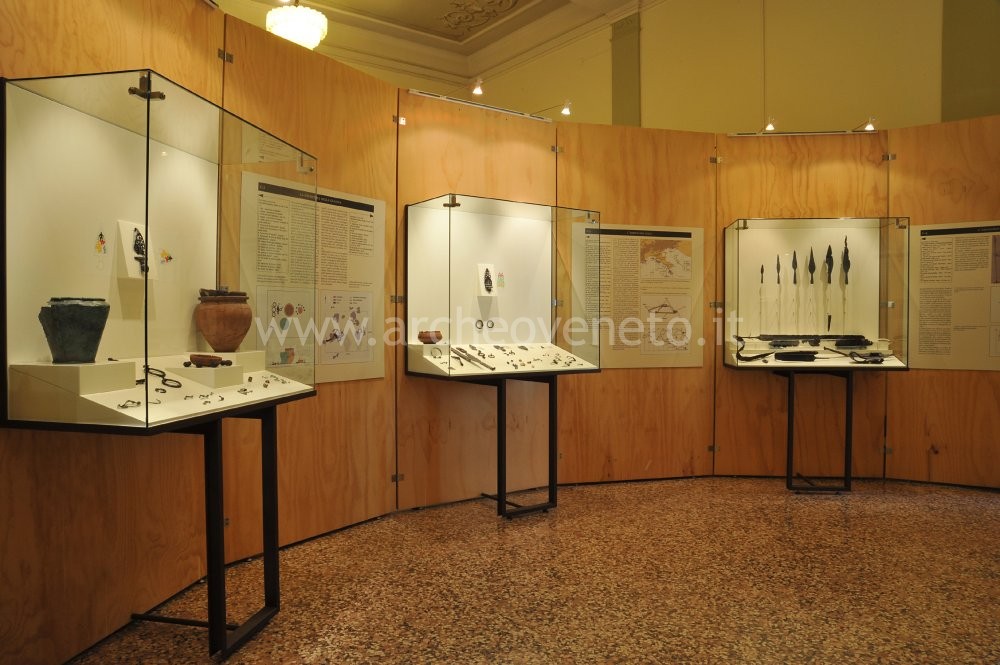 The material collected in this room comes mostly from the necropolis of Gualiva nearby Montebello Vicentino, characterized by burials which can be dated back to the 7th and 1st century B.C. The first two display cases, including two burial sets of grave goods, witness to the existence of Celtic people and influences inside the local community. The first display case contains the goods of the grave 4 (end of the 5th century B.C.) made up of materials of the local tradition, such as the pottery and fibulas decorated with a pattern reproducing the dotted face of a dice and of Celtic tradition, as the beautiful pierced belt hook depicting the master of the beasts. Also the grave 2 shows the coexistence of more peoples, witnessed by the finding of a pierced belt hook depicting the subject of the zoomorphic lira (two fighting dragons) associated to local ornamental objects. The presence inside the same burial of an iron knife with its sheath makes us think of a contact with people from the central and eastern Alpine region. The same display case containing the goods of the grave 2 contains the so-called sporadic materials among which four pierced belt hooks stand out. The material collected in this room comes mostly from the necropolis of Gualiva nearby Montebello Vicentino, characterized by burials which can be dated back to the 7th and 1st century B.C. The first two display cases, including two burial sets of grave goods, witness to the existence of Celtic people and influences inside the local community. The first display case contains the goods of the grave 4 (end of the 5th century B.C.) made up of materials of the local tradition, such as the pottery and fibulas decorated with a pattern reproducing the dotted face of a dice and of Celtic tradition, as the beautiful pierced belt hook depicting the master of the beasts. Also the grave 2 shows the coexistence of more peoples, witnessed by the finding of a pierced belt hook depicting the subject of the zoomorphic lira (two fighting dragons) associated to local ornamental objects. The presence inside the same burial of an iron knife with its sheath makes us think of a contact with people from the central and eastern Alpine region. The same display case containing the goods of the grave 2 contains the so-called sporadic materials among which four pierced belt hooks stand out.
The museum goes on with a panel related to the arrival of the Celts to the Venetian area, whose presence influenced also the funerary habits of the local people; at this point, weapons started to be laid inside the burials characterizing the war habits of the deceased.
The considerable presence of weapons is witnessed by a display case containing a knife with a decorated sheath, four iron swords with their sheaths, five spearhead and javelin heads coming from occasional findings in the necropolis of Gualiva.
It is ascertained that this same necropolis was not abandoned during the Romanization period, which confirms this territory was inhabited until the 1st century B.C. The last case of the room summarizes this transition phase thanks to the display of materials coming both from necropolis (grave 3 and sporadic materials, necropolis of Gualiva, Montebello Vicentino) and from the dwellings (Montecchio: via Cà Rotte,
Patronato Sant’Antonio, San Giacomo Nord- dwellings and necropolis- and San Giacomo Sud).
|

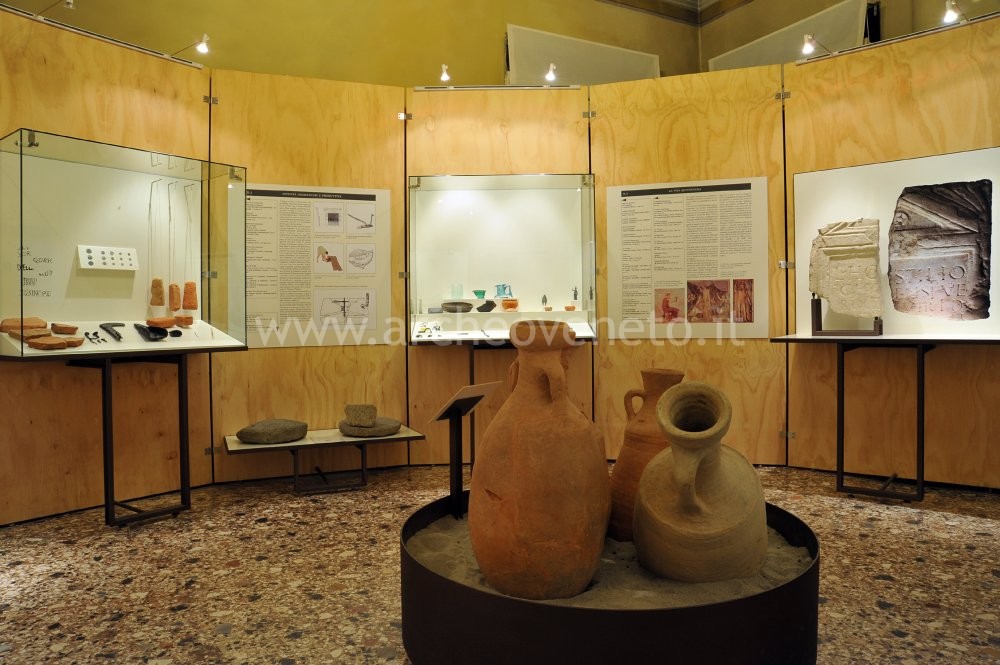 This room is dedicated to the organization of the area of Vicenza in the Roman Age and to its material expressions. This room is dedicated to the organization of the area of Vicenza in the Roman Age and to its material expressions.
During this period, the area interested by the previous settlements belonged to the Municipium of Vicetia from an administrative point of view; this is also witnessed by the finding nearby Pieve di S. Maria and S. Vitale in Montecchio Maggiore, of a fragment of a funerary stone of a quattuorvir of the Town Hall of Vicenza.
The exhibition goes on with the topic of the daily life. The display case dealing with this topic contains a fine small bronze of Minerva (1st-2nd century A.D.) from via Campestrini, a lamp with a grotesque ithyphallic bronze figure (1st-2nd century A.D.), an Aucissa fibula (1st century A.D.) from via Cà Rotte, a pliers-shaped fibula from via delle Tasse, a small cosmetic plate and other materials coming from the Montecchio area as well as a spoon and a hair pin from Arzignano, Cava Poscola and two iron and bronze keys (1st – 4th A.D.) from Altavilla, Pretto Property.
The following topic is about the household and productive activities documented by two large querns from Montecchio, truncated conical loom weights from the Patronage of S.Antonio in Montecchio, stamped tiles, needles, nails, a sickle and a plowshare from Montecchio and Altavilla and different coins dating back to the mid 4th century A.D. At the end of this section, in the middle of the room, there are four different types of amphorae which cover a chronological period between the end of the 2nd century B.C. and the 3rd century A.D.
The last part of the room is dedicated to the world of the dead which, as far as the 1st century A.D. is concerned, is represented by the grave 4 of the necropolis of Arzignano, Cava Poscola.
However, the necropolis which provided with most of the objects is the Late Antique necropolis (4th century A.D.) of Carpane nearby Montecchio; different pieces of pottery, metal decoration and glass objects were found here. In a small room adjoining the Room 4, there is an interesting child burial without any grave goods located inside a non-operating trachyte pipeline coming from the same necropolis of Carpane.
The last burial shown belongs probably to an East Germanic knight serving the Roman army discovered in 1995 in Arzignano, Cava Poscola. This shows objects of the 5th century A.D. of Eastern (a long sword with its sheath, a short sword, some fragments of a quiver with arrows and footwear buckles) and Roman tradition (belt buckle and items of the Roman funerary ritual). The presence of horse bones confirms the military role of the deceased.
|

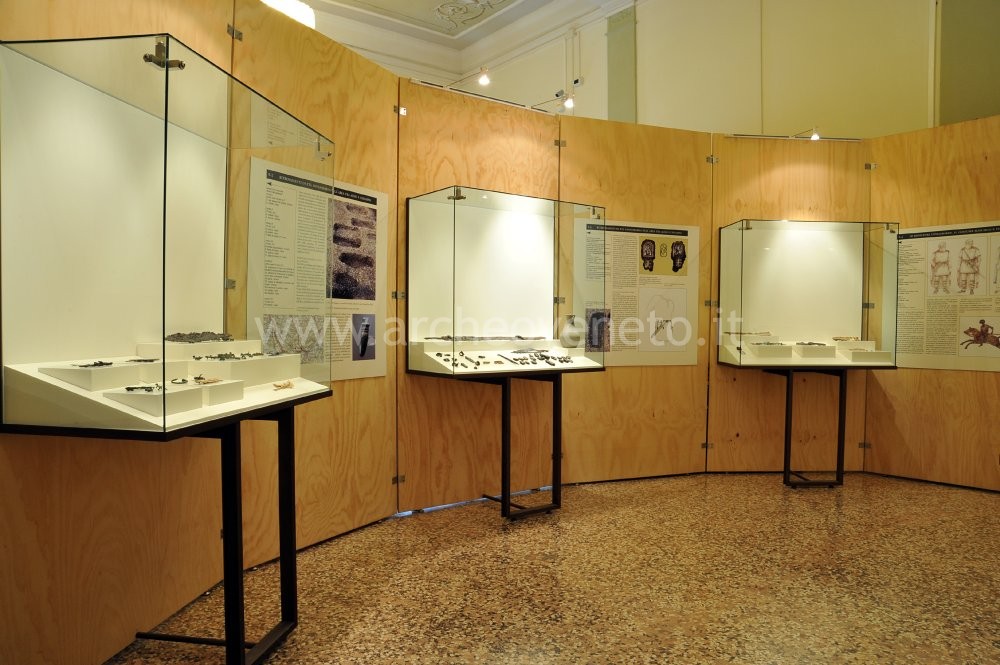 This room collects the finds of the Lombard Age with male and female grave goods from Montecchio, S.Urbano, Arzignano and Castelgomberto. This room collects the finds of the Lombard Age with male and female grave goods from Montecchio, S.Urbano, Arzignano and Castelgomberto.
|
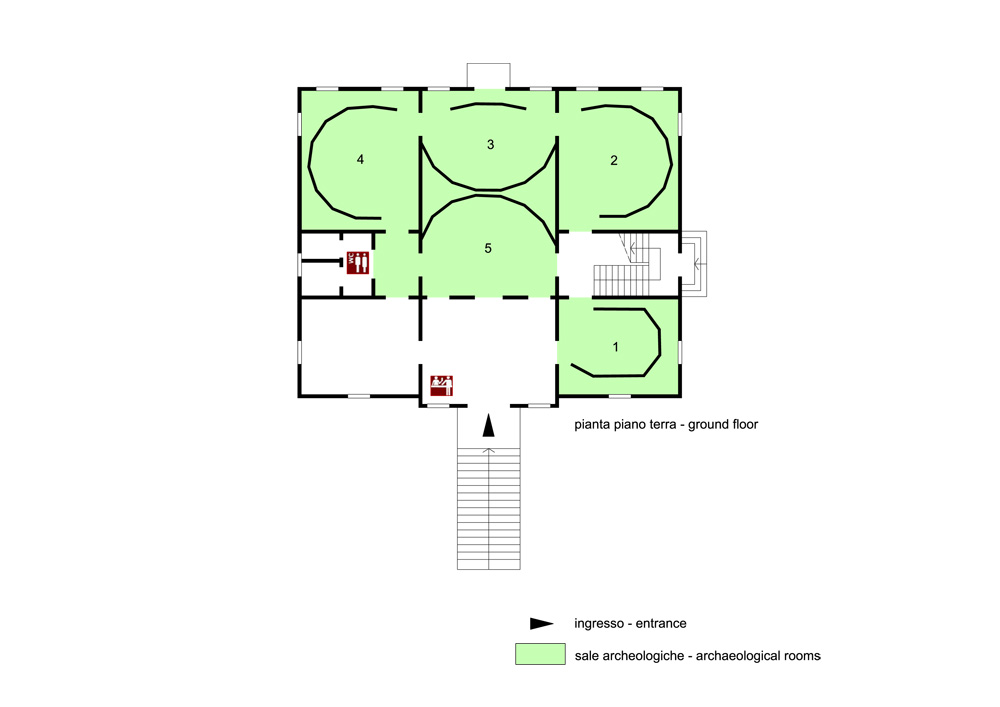
Admission: Negli orari di apertura
Solo su prenotazione
Su prenotazione
Ticket: Si
Price: 1 € adults; 0.50 € children below 18 years of age; free admission for people aged more than 65.
 School access School access
Opening Days
| Tipology |
When |
Specs |
| Summer/Winter |
Monday |
Upon reservation |
| Summer/Winter |
Tuesday |
Upon reservation |
| Summer/Winter |
Wednesday |
Upon reservation |
| Summer/Winter |
Thursday |
Upon reservation |
| Summer/Winter |
Friday |
09.00-12.30 |
| Summer/Winter |
Saturday |
09.00-12.30 e 15.00-18.30 |
| Summer/Winter |
Sunday |
09.00-12.30 e 15.00-18.30 |
Recommended tour time (minutes): 75
 Brochure Brochure
Italian
 Information boards Information boards
Italian
 Captions under exhibits Captions under exhibits
Italian
 Guided Tours Guided Tours
 Educational activities Educational activities
 Educational workshops Educational workshops
 Library and documentation centre Library and documentation centre
 Other activities Other activities
| Musei e raccolte archeologiche del Veneto 2004, a cura di Di Mauro A., Dosson di Casier, pp. 140. |
| Ghiotto R., Bruttomesso A., Chilese L., Frisone V. 2007, Il riallestimento del Museo di Archeologia e Scienze Naturali “G. Zannato”, in Studi e ricerche, 14, Montecchio Maggiore , pp. 5-10. |
| Bonetto J. 2009, Veneto (Archeologia delle Regioni d’Italia), Roma, pp. 376-378. |
|

